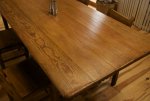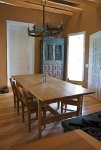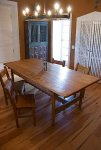Chris Ferguson
Member
- Messages
- 6
- Location
- Northern New Mexico
Greetings all,
I'm prototyping finishes for a collection of reproduction New Mexican furniture, all built from ponderosa pine. I'm not using stains as stains/dyes do not produce believable results with pine... (seasoned pine finishes have been my life's work in recent years) and I'm pleased with the colors I'm getting but my current objective is the dining table top that I'm tweaking at present. My goals are surfaces that resemble aged antique wood yet are durable for table use... not an easy task! In my process I waxed the table and it looks perfect but wax and table tops will never make for lasting relationships. I stripped, scrubbed the top with a potassium hydroxide solution and neutralized it with vinegar, then simply sponge scrubbed it with water to remove the remnant lye... after thorough drying and wiskering with 0000 steel wool I'm ready to seal the surface but this is my dilemma, I don't want an artificial material especially but I also don't want staining and white rings every time a glass sweats or something is spilled. I've read other threads here suggesting gel varnishes and gel urethane, rubbed on and built up as an oil finish. I like the idea but don't want a coated appearance or gloss surface... worn, seasoned pine furniture isn't "fine" and has it's own set of rules, what I need is something that isn't problematic for real world table use. Any ideas or suggestions? I'll attach a picture of the table top to clarify what I'm talking about...
Thanks,
Chris
I'm prototyping finishes for a collection of reproduction New Mexican furniture, all built from ponderosa pine. I'm not using stains as stains/dyes do not produce believable results with pine... (seasoned pine finishes have been my life's work in recent years) and I'm pleased with the colors I'm getting but my current objective is the dining table top that I'm tweaking at present. My goals are surfaces that resemble aged antique wood yet are durable for table use... not an easy task! In my process I waxed the table and it looks perfect but wax and table tops will never make for lasting relationships. I stripped, scrubbed the top with a potassium hydroxide solution and neutralized it with vinegar, then simply sponge scrubbed it with water to remove the remnant lye... after thorough drying and wiskering with 0000 steel wool I'm ready to seal the surface but this is my dilemma, I don't want an artificial material especially but I also don't want staining and white rings every time a glass sweats or something is spilled. I've read other threads here suggesting gel varnishes and gel urethane, rubbed on and built up as an oil finish. I like the idea but don't want a coated appearance or gloss surface... worn, seasoned pine furniture isn't "fine" and has it's own set of rules, what I need is something that isn't problematic for real world table use. Any ideas or suggestions? I'll attach a picture of the table top to clarify what I'm talking about...
Thanks,
Chris


 Northern NM is one of my favorite places in the country.
Northern NM is one of my favorite places in the country.

